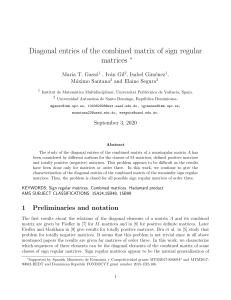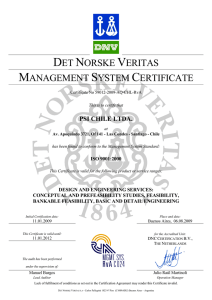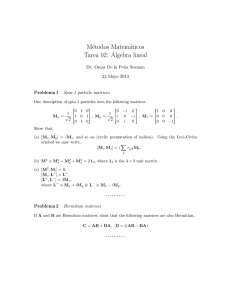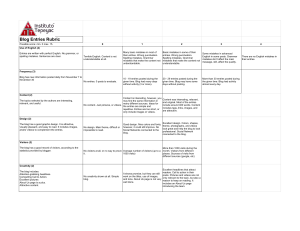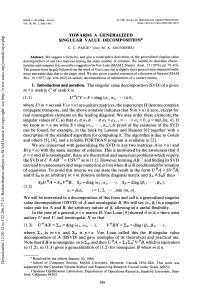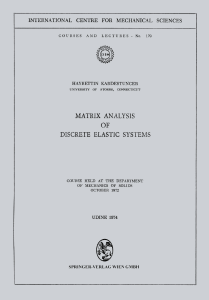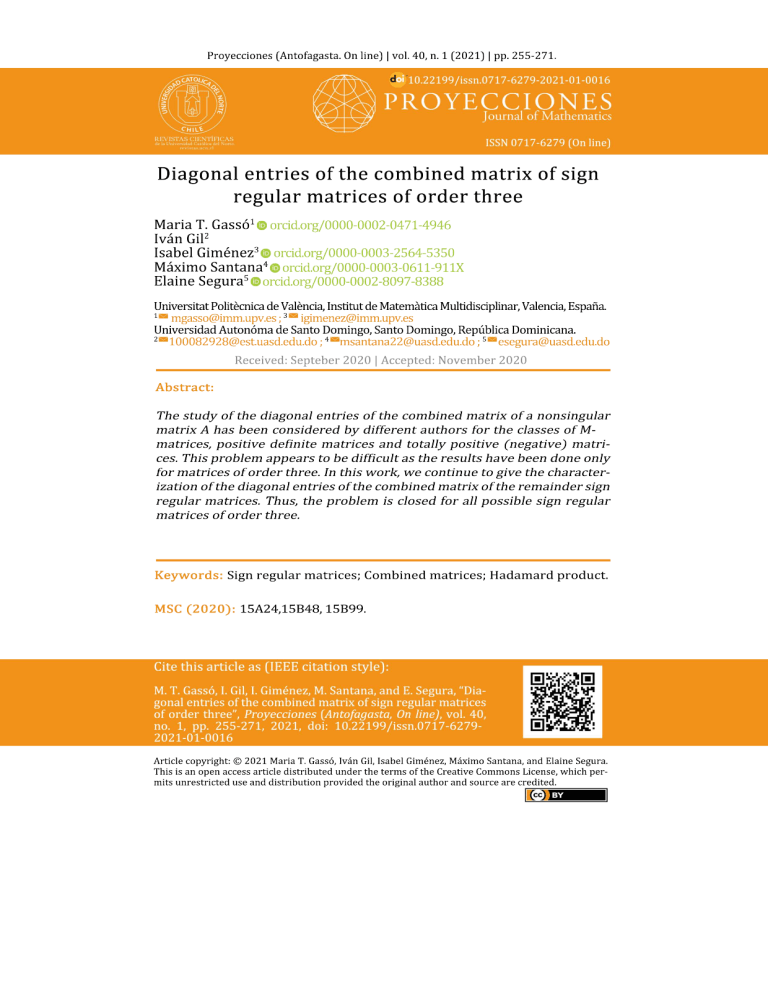
256
M. T. Gassó, I. Gil, I. Giménez, M. Santana and E. Segura
1. Preliminaries and notation
The first results about the relations of the diagonal elements of a matrix
A and its combined matrix are given by Fiedler in [5] for M —matrices and
in [6] for positive definite matrices. Later Fiedler and Markham in [7] give
results for totally positive matrices. Bru et al. in [4] study that problem for
totally negative matrices. It seems that this problem is not trivial since in
all above mentioned papers the results are given for matrices of order three.
In this work, we characterize which sequences of three elements can be the
diagonal elements of the combined matrix of some classes of sign regular
matrices. Sign regular matrices appear to be the natural generalization of
totally positive or negative matrices and they have been a lot of attention by
different authors (see in [9] and the references therein). Results of combined
matrices of sign regular matrices are given in [3] and more recently in [1].
Throughout this paper all matrices are real. We recall that the combined
matrix Φ(A) of a nonsingular matrix A is defined as Φ(A) = A ◦ A−T ,
where ◦ denotes the Hadamard product, (A ◦ B)ij = aij bij . The combined
P
P
matrix Φ(A) = (cij ) has the property that j cij = i cij = 1 for each
row and column. As a consequence, if Φ(A) ≥ 0, then Φ(A) is a doubly
stochastic matrix. In [8] the interesting relationship among diagonal entries
and the eigenvalues of a diagonalizable matrix is given. On the other hand,
applications of combined matrices to chemical problems can be viewed in
[2].
A property of combined matrices that we are going to use is the following: If we multiply the matrix A by a nonsingular diagonal matrix, from
the left or from the right, its combined matrix Φ(A) does not change.
Given a signature , that is, a real sequence { 1 , . . . , k , . . . , n } such
that | k | = 1 for all 1 ≤ k ≤ n, we recall that an n × n matrix A is called
sign regular with signature = ( k ) if for all 1 ≤ k ≤ n and α1 , α2 ∈ Qk,n ,
we have
k det(A[α1 , α2 ]) > 0
where Qk,n denotes the set of all increasing sequences of k natural numbers
less than or equal to n and A[α1 , α2 ] is the submatrix of A containing rows
numbered by α1 and columns numered by α2 (see [9]).
2. Results
With matrices of order 3, we have to consider 8 possible sub-cases. However,
they can be grouped into four sub-cases. This is because the combined
Diagonal entries of the combined matrix of sign regular matrices ...257
matrix of the matrices A and −A is the same and the signatures of both
matrices are opposite with the exception of the second entry because the
minors of order 2 do not change.
Then we have the following equivalent pairs of signatures: (i) (1, 1, 1) ↔
(−1, 1, −1), (ii) (−1, −1, −1) ↔ (1, −1, 1), (iii) (1, 1, −1) ↔ (−1, 1, 1) (iv)
(1, −1, −1) ↔ (−1, −1, 1). The first case (i) was obtained by Fiedler and
Markham [7] and corresponds to the totally positive matrices. The second
case (ii) was studied by Bru et al.[4] when the totally negative matrices
were considered.
It remains to prove the last two cases that we are going to consider
in two different subsections. Thus, this problem will be closed for all sign
regular matrices of order three.
2.1. Sign regular matrices with signature (1, 1, −1) or (−1, 1, 1)
We give the result for the (1, 1, −1) case, which is equivalent to the (−1, 1, 1)
case. To prove the main result of this case we will use the following lemma.
Lemma 1. Let A be a 3 × 3 matrix. Then, it is (1,1,-1)—sign regular if
and only if it is positively diagonally equivalent to the matrix
⎡
v1
v1 −1
1
1 1
q 1
⎢
S=⎣
(2.1)
where
(2.2)
⎤
p
⎥
1 ⎦
v3
v3 −1
v1 , v3 > 1
(2.3)
0 < p, q < 1
(2.4)
s = 1 − (1 − p)(1 − q)(v1 − 1)(v3 − 1) < 0
Proof.
(⇒) Suppose that the matrix
⎡
⎤
a11 a12 a13
⎢
⎥
A = ⎣ a21 a22 a23 ⎦
a31 a32 a33
is a (1,1,-1)—sign regular matrix. By the equality
⎡ a a
11 22
1
⎢ a12 a21
1 1
S=⎣
a22 a31
a21 a32
(2.5)
1
a13 a22
a12 a23
⎤
⎥
⎡
⎢
1 ⎦=⎣
a22 a33
a23 a32
1
a12
0
0
0
1
a22
0
⎤⎡
⎤⎡ a
22
0
a11 a12 a13
⎢
⎥⎢
0 ⎥
⎦ ⎣ a21 a22 a23 ⎦ ⎣
1
a31 a32 a33
a32
0
0 1
0 0
a21
⎤
0
⎥
0 ⎦
a22
a23
258
M. T. Gassó, I. Gil, I. Giménez, M. Santana and E. Segura
we observe that the matrix A is positively diagonally equivalent to the mav
⇔
trix S. Moreover, taking into account the general equivalence xy = v−1
⎡ v
⎤
1
1
p
⎢ v1 −1
⎥
x
1 1
1 ⎦ where
v = x−y , we can write S as follows S = ⎣
3
q 1 v3v−1
vi =
aii a22
, for i = 1, 3,
aii a22 − ai2 a2i
p=
a13 a22
a22 a31
> 0 and q =
> 0.
a12 a23
a21 a32
Let us see that p, q, v1 and v3 satisfy conditions (2.2), (2.3) and (2.4).
Let Aij denote the 2 × 2 submatrix of A deleting row i and column j from
A. Since A is (1,1,-1)—sign regular, we conclude the following results.
1. Since det(A33 ) = (a11 a22 − a12 a21 ) > 0, we have v1 > 1.
2. From the positive sign of det(A11 ) > 0, we obtain v3 > 1.
3. Since det(A31 ) = (a12 a23 − a13 a22 ) > 0 we deduce that p < 1. Then
0 < p < 1.
4. Similarly, with det(A13 ) = (a21 a32 − a31 a22 ) > 0 we obtain that
0 < q < 1.
5. By the equation (2.1) we have
1 − (1 − p)(1 − q)(v1 − 1)(v3 − 1)
< 0.
det(S) =
(v1 − 1)(v3 − 1)
That is, (1 − p)(1 − q)(v1 − 1)(v3 − 1) > 1 since (v1 − 1)(v3 − 1) > 0.
Hence, S has the required form and the entries satisfy the corresponding
conditions.
(⇐) Conversely, suppose that A is positively diagonally equivalent to matrix S and the conditions (2.2), (2.3) and (2.4) are satisfied. In this case, it
remains to prove that the matrix S is (1,1, -1)—sign regular since A and S
have the same signature. Let us verify the sign of all determinants of order
1, 2 and 3.
1. Determinants of order 1. Note that sij > 0 for i, j = 1, 2, 3, since
i
> 0, i = 1, 3, by (2.2).
p, q > 0 by (2.3) and viv−1
2. Determinants of order 2.
• det(S11 ) =
0 by (2.2).
³
v3
v3 −1
´
−1 =
1
v3 −1
> 0 and det(S33 ) =
³
v1
v1 −1
´
−1 >
Diagonal entries of the combined matrix of sign regular matrices ...259
• det(S13 ) = (1 − q) > 0, and det(S31 ) = (1 − p) > 0 by (2.3).
• det(S12 ) =
³
In the same
³
v1
v1 −1
´
−p >
• det(S22 ) =
³
v3
v3 −1
v3
v3 −1
´
³
´
−q >
v3
v3 −1
−1=
³
1
v3 −1
> 0 by (2.2).
´
3
−p
way: det(S21 ) = v3v−1
³
´
v1
0, and det(S23 ) = v1 −1 − q
v1
v3
v1 −1 v3 −1
− pq
− q > 0 by (2.3).
´
> 0 since
³
> 0, det(S32 ) =
> 0.
v1
v1 −1
´
−p
> 0 and
3. Determinant of S. It is clear that det(S) < 0 by (2.2) and (2.4).
Therefore, S is sign regular with signature (1, 1, −1) and so the given matrix
A. 2
Remark 1. It is well known that a necessary and sufficient condition for
the system
equations xy = f , (1 − x)(1 − y) = g has solutions x, y ∈]0, 1[
√ of √
is that f + g ≤ 1.
Theorem 1. A necessary and sufficient condition for three numbers, u1 , u2 , u3 ,
to be the diagonal entries of the combined matrix of a (1,1,-1)—sign regular
matrix is that ui < 0, i = 1, 2, 3, and
(2.6)
u1 + u3 − u2 − 1 > 0.
Proof.
(⇒) Note that ui < 0, i = 1, 2, 3, since the diagonal entries of
the combined matrix of a (1,1,-1)—sign regular matrix A are
ui =
aii det Aii
,
det A
i = 1, 2, 3.
Recall that our (1,1,-1)—sign regular matrix is positively diagonally
equivalent to the matrix S given in (2.1) with the three conditions (2.2),
(2.3) and (2.4) by Lemma 1. The combined matrix of S, Φ(S) has the
following diagonal entries:
u1 =
v1
,
s
u2 =
v1 v3 − pq(v1 − 1)(v3 − 1)
,
s
u3 =
where
(2.7)
s = 1 − (1 − p)(1 − q)(v1 − 1)(v3 − 1) < 0,
v3
s
260
M. T. Gassó, I. Gil, I. Giménez, M. Santana and E. Segura
which is the numerator of det(S). From conditions (2.2) — (2.4) we deduce
that ui < 0, i = 1, 2, 3.
Let us verify the second condition of the three numbers u1 , u2 and u3 .
u1 + u3 − u2 − 1 =
=
=
1
(v1 + v3 − v1 v3 + pq(v1 − 1)(v3 − 1) − s)
s
1
(v1 + v3 − v1 v3 + (pq + (1 − p)(1 − q))(v1 − 1)(v3 − 1) − 1)
s
1
((p(q − 1) + q(p − 1))(v1 − 1)(v3 − 1)) > 0
s
using conditions (2.2) — (2.4).
With the given conditions for the three numbers u1 , u2 and u3 we are going
to built a matrix S given in Lemma 1 with the structure of (2.1) and
conditions (2.2)-(2.4) such that u1 , u2 , u3 are the diagonal entries of its
combined matrix Φ(S). For that, let
(2.8)
u1 =
v1
,
s
u2 =
v1 v3 − pq(v1 − 1)(v3 − 1)
,
s
u3 =
v3
s
with the unknowns v1 , v3 , p, q. The variable s is defined in (2.7). These
unknowns define the entries of matrix S. Observe that u2 s = −pq(v1 −
1)(v3 − 1) + v1 v3 implies
(2.9)
pq =
−u2 s + u1 u3 s2
.
(u1 s − 1)(u3 s − 1)
From definition of s in (2.7), it follows
(1 − p)(1 − q) =
(2.10)
(1 − s)
·
(u1 s − 1)(u3 s − 1)
Then, to determine p and q we are going to work with (2.9) and (2.10).
Using the equivalence of the Remark 1, the system given by equations
(2.9) and (2.10) has solutions p, q ∈]0, 1[ if and only if
(2.11)
s
−u2 s + u1 u3 s2
+
(u1 s − 1)(u3 s − 1)
s
1−s
≤ 1.
(u1 s − 1)(u3 s − 1)
Let us see if the above inequality holds for the value s =
case, the equation (2.12) reduces to
u2
. In this
u1 u3
Diagonal entries of the combined matrix of sign regular matrices ...261
(2.12)
s
1−s
1−s
≤1⇔0≤
≤1
(u1 s − 1)(u3 s − 1)
(u1 s − 1)(u3 s − 1)
which is well defined. In fact
(2.13) (u1 s − 1)(u3 s − 1) = 1 −
u2 u2
u2
u1 u3 − u2 u3 − u2 u1 + u22
−
+ 2 =
>0
u1 u3 u1 u3
u1 u3
since
u1 u3 − u2 u3 − u2 u1 + u22 = u1 u3 + u2 (−u3 − u1 + u2 + 1) − u2 > 0
because ui < 0 for i = 1, 2, 3 and −1 + u3 + u1 − u2 > 0. Note that the
discriminant of (2.12) is positive.
Moreover,
(1 − s) − (u1 s − 1)(u3 s − 1) =
=
µ
u2
1−
u1 u3
¶
Ã
u2 u2
u2
− 1−
−
+ 2
u1 u3 u1 u3
!
u2 (−1 + u3 + u1 − u2 )
< 0,
u1 u3
since ui < 0 for i = 1, 2, 3 and the condition (2.6), which means that the
u2
· Then, our equations (2.9) and (2.10)
inequality (2.11) holds with s =
u1 u3
have solutions for some p < 1 and 0 < q < 1.
u2
u2
In addition, v1 = u1 s =
> 1 and v3 = u3 s =
> 1 since the
u3
u1
inequality (2.6) and ui < 0, i = 1, 2, 3.
Finally, it can be computed that the diagonal elements of the combined
matrix of S are
diag(Φ(S)) =
µ
¶
v1 v1 v3 − pq(v1 − 1)(v3 − 1) v3
,
,
,
s
s
s
which are precisely the elements (u1 , u2 , u3 ) of equations 3equ. Then, we
have found a solution for the unknowns v1 , v3 , p and q with the value
u2
in which case det(S) < 0. However, p or q must be zero. It is
s=
u1 u3
u2
− with the appropriate
easy to check that the result follows with s =
u1 u3
value for > 0, in which case 0 < p < 1 and 0 < q < 1. Note that with
these conditions the matrix S is (1,1,-1)—sign regular by Lemma 1. 2
262
M. T. Gassó, I. Gil, I. Giménez, M. Santana and E. Segura
Example 1. (⇒) Let the (1,1,-1)—sign regular matrix
⎡
⎤
1.2 1 0.2
⎢
⎥
1 ⎦
S=⎣ 1 1
0.5 1
2
where v1 = 6, v3 = 2, p, q ∈]0, 1[ and s = −1. Its combined matrix is
⎡
⎤
−6
7.5 −0.5
⎢
⎥
Φ(S) = ⎣ 9 −11.5
3.5 ⎦
−2
5
−2
and its diagonal entries are negative and satisfy
u1 + u3 − u2 − 1 = 2.5 > 0.
(⇐) Let the three negative numbers u1 = −6, u2 = −17 and u3 = −6.
Note that u1 + u3 − u2 − 1 = 4 > 0.
According to the proof of Theorem 1, we can choose s = uu1 u2 3 − = −0.5.
We obtain the parameters p, q ∈]0, 1[ solving the system (2.9)-(2.10), and
the parameters v1 , v3 > 1 solving (2.8). So, we construct the matrix
⎡
⎤
1.5 1 0.25
⎢
⎥
S=⎣ 1 1
1 ⎦
0.5 1 1.5
with all conditions of Lemma 1 fulfilled. Then , u1 , u2 , u3 are the diagonal
entries of the combined matrix of the (1,1,-1)—sign regular matrix S:
⎡
⎤
−6
8 −1
⎢
⎥
8 ⎦
Φ(S) = ⎣ 10 −17
−3
10 −6
2.2. Sign regular matrices with signature (1, −1, −1) or (−1, −1, 1)
Now, we study the last case. In particular, of these two equivalent cases,
we will consider the case with signature (1, −1, −1). Let us start with the
following result.
Lemma 2. Let A = [aij ] be a 3 × 3 matrix, where aij > 0, i, j = 1, 2, 3.
Then, A is (1,-1,-1)—sign regular if and only if it is positively diagonally
equivalent to the matrix
(2.14)
⎡
⎢
T =⎣
v1
v1 −1
1
1 1
q 1
⎤
p
⎥
1 ⎦
v3
v3 −1
Diagonal entries of the combined matrix of sign regular matrices ...263
(2.15)
v1 , v3 < 0
(2.16)
p, q > 1
(2.17)
t = 1 − (p − 1)(q − 1)(v1 − 1)(v3 − 1) < 0
(⇒) Reasoning as in⎡Lemma 1 we obtain
⎤ a matrix T positively
v1
1
p
⎢ v1 −1
⎥
1 1
1 ⎦ where
equivalent to A given by T = ⎣
3
q 1 v3v−1
Proof.
vi =
aii a22
for i = 1, 3,
aii a22 − ai2 a2i
p=
a13 a22
a22 a31
and q =
.
a12 a23
a21 a32
Let us see that p, q, v1 , v3 and t satisfy conditions (2.2), (2.3) and (2.4).
Let Aij denote the 2 × 2 submatrix of A deleting row i and column j
from A. Since A is (1,-1,-1)—sign regular, we have
1. Since det(A33 ) = (a11 a22 − a12 a21 ) < 0, and det(A11 ) < 0 we have
v1 < 0 and v3 < 0. Then, condition (2.2) is fulfilled.
2. Since det(A31 ) = (a12 a23 − a13 a22 ) < 0 we deduce that p > 1. Moreover q > 1 since det(A13 ) = (a21 a32 − a31 a22 ) < 0, that is, (2.3)
holds.
3. Since A and T have the same determinant, then
(2.18)
det(T ) =
1 − (p − 1)(q − 1)(v1 − 1)(v3 − 1)
(v1 − 1)(v3 − 1)
is negative. This implies that t < 0 which is the condition (2.4).
Therefore, T has the required form and the entries satisfy the corresponding conditions (2.2)—(2.4).
(⇐) Conversely, suppose that A is positively diagonally equivalent to matrix T and the conditions (2.2), (2.3) and (2.4) are satisfied. In this case, it
remains to prove that the matrix T is (1,-1, -1)—sign regular since A and T
have the same signature. Let us verify the sign of all determinants of order
1, 2 and 3.
1. Determinants of order 1. All of them are positive according to conditions (2.2) and (2.3).
2. Determinants of order 2.
264
M. T. Gassó, I. Gil, I. Giménez, M. Santana and E. Segura
• det(T11 ) =
0 by (2.2).
³
v3
v3 −1
´
−1 =
1
v3 −1
< 0 and det(T33 ) =
³
v1
v1 −1
´
−1 <
• det(T13 ) = (1 − q) < 0, and det(T31 ) = (1 − p) < 0 by (2.3).
• det(T12 ) =
³
v3
v3 −1
´
−q <
Similarly, det(T21 ) =
0, and det(T23 ) =
• det(T22 ) =
³
v3
v3 −1
´
³
³
³
− q < 0.
v3
v3 −1
v1
v1 −1
v1
v3
v1 −1 v3 −1
v3
v3 −1 −1
´
=
1
v3 −1
< 0 by (2.3) and (2.2) .
− p < 0, det(T32 ) =
´
− q < 0.
− pq
´
< 0 since
³
v1
v1 −1
³
v1
v1 −1
−p
´
´
−p <
< 0 and
3. Determinant of T . It is clear that det(T ) < 0 by (2.18), (2.17) and
(2.15).
Therefore, T is sign regular with signature (1, −1, −1) and the given
matrix A also. 2
Theorem 2. A necessary and sufficient condition for three numbers, u1 , u2 , u3
to be the diagonal entries of the combined matrix of a (1, −1, −1)—sign regular matrix is that ui > 0, i = 1, 2, 3, and
√
√
√
u1 + u3 − u2 + 1 ≤ 0.
(2.19)
Proof. (⇒) Note that the diagonal entries of the combined matrix of a
(1,-1,-1)—sign regular matrix A are
aii det Aii
> 0, i = 1, 2, 3.
det A
In addition, any (1,-1,-1)—sign regular matrix is positively diagonally
equivalent to the matrix T of matrix-T with the conditions (2.2)-(2.4) given
in Lemma 2. As before, the combined matrix of T , Φ(T ), has the following
diagonal entries:
ui =
(2.20)
u1 =
v1
v1 v3 − pq(v1 − 1)(v3 − 1)
v3
, u2 =
, u3 =
t
t
t
where
t = 1 − (1 − p)(1 − q)(v1 − 1)(v3 − 1) < 0. Then,
(2.21)
pq =
−u2 t + u1 u3 t2
(u1 t − 1)(u3 t − 1)
Diagonal entries of the combined matrix of sign regular matrices ...265
from the second diagonal entry. Moreover, we can write (2.4) as
(2.22)
(1 − p)(1 − q) =
1−t
·
(−1 + u1 t)(−1 + u3 t)
From theÃlast two equations, we have!
−u2 t + u1 u3 t2
1−t
(1-q) 1 −
·
=
q(−1 + u1 t)(−1 + u3 t)
(−1 + u1 t)(−1 + u3 t)
Simplifying, we have
q 2 (−1 + u1 t)(−1 + u3 t) + q(−1 + u1 + u2 + u3 − 2u1 u3 t)t
(2.23)
− t(u2 − u1 u3 t) = 0.
We have two real values p, q > 1 satisfying equation (2.23). This implies
that its discriminant is greater than or equal to zero, that is
(t2 4u1 u3 +t(1−2u1 +u21 −2u2 −2u1 u2 +u22 −2u3 −2u1 u3 −2u2 u3 +u23 )+4u2 )t ≥ 0.
(2.24)
The corresponding equation, related to (2.24), has the solution t = 0 plus
the roots of the quadratic equation
t2 4u1 u3 +t(1−2u1 +u21 −2u2 −2u1 u2 +u22 −2u3 −2u1 u3 −2u2 u3 +u23 )+4u2 = 0.
(2.25)
To have all real roots, again its discriminant must be greater than or
equal to zero, that is
³
´2
−64u1 u2 u3 + u21 + u22 + (−1 + u3 )2 − 2u2 (1 + u3 ) − 2u1 (1 + u2 + u3 ) ≥ 0.
(2.26)
The corresponding equation, related to (2.26), is of fourth degree with
the variable u2 and has the possible solutions:
√ √
√
√
x1 = 1 + u1 + 2 u1 u3 + u3 + 2| u1 − u3 |,
√ √
√
√
x2 = 1 + u1 − 2 u1 u3 + u3 − 2| u1 − u3 |,
√ √
√
√
x3 = 1 + u1 − 2 u1 u3 + u3 + 2 ( u1 + u3 ) ,
√ √
√
√
x4 = 1 + u1 + 2 u1 u3 + u3 + 2 ( u1 + u3 ) .
Then, there are three possible regions for u2 where (2.26) holds. The
first region is when u2 is greater than or equal to the biggest root x4 =
266
M. T. Gassó, I. Gil, I. Giménez, M. Santana and E. Segura
¡
√
√ ¢2
1 + u1 + u3 . In this case u2 ≥ x4 which is inequality (2.19) of our
theorem.
The possibility that u2 be in the other two regions is null, as we are
going to see by contradiction.
The second possible region where the discriminant is not negative is
determined by two of the three roots, x1 , x2 , x3 depending on they are
different and which one is the smallest.
If we suppose
without
loss of gen¡
¡
√
√ ¢2
√
√ ¢2
erality that u1 ≥ u3 , then x1 = 1 + u1 − u3 , x2 = 1 − u1 + u3
¡
¢
√
√ 2
and x3 = 1 − u1 − u3 . (Note that, if u1 ≤ u3 , the roots x1 and x2
interchange its values.)
The expressions of the roots of (2.24) are
1
t=
8u1 u3
q
µ
− 1 + 2u1 − u21 + 2u2 + 2u1 u2 − u22 + 2u3 + 2u1 u3 + 2u2 u3 − u23
± −64u1 u2 u3 +
¡
1 − 2u1 + u21
− 2u2 − 2u1 u2 + u22
¢2
− 2u3 − 2u1 u3 − 2u2 u3 + u23
(2.27)
Since u1 , u2 , u3 > 0, the roots of equation (2.27) are positive if and only if
b = 1 − 2u1 + u21 − 2u2 − 2u1 u2 + u22 − 2u3 − 2u1 u3 − 2u2 u3 + u23 < 0.
Note that the value of b is negative when u2 is between the two roots
√
√
b1 = 1+u1 +u3 −2 u1 + u3 + u1 u3 and b2 = 1+u1 +u3 +2 u1 + u3 + u1 u3 .
Then, if u2 goes into this region the function b will be negative and the roots
of t positive which will be a contradiction with our point of depart where
we have that t < 0.
Let us see that our second region defined by x1 , x2 or x3 is included in
the interval with bounds b1 and b2 .
First note that b2 > x1 , x2 , x3 since
√
¡√
¢
√
√
b2 − x1 = 2 u3 − u1 + u1 u3 + u1 + u3 + u1 u3
√
¡√
¢
√
√
b2 − x2 = 2 u1 − u3 + u1 u3 + u1 + u3 + u1 u3
√
¡√
¢
√
√
b2 − x3 = 2 u1 + u3 − u1 u3 + u1 + u3 + u1 u3
where the three differences are positive because
√
√ √ √
u1 + u3 + u1 u3 > u1 , u3 , u1 u3 .
For the lower bound b1 we can see that b1 is less than at least two of
the three roots x1 , x2 , x3 , two of them defining the second region.
¶
.
Diagonal entries of the combined matrix of sign regular matrices ...267
• For all u1 ≥ u3 > 0, we have
b1 < x1 ⇔
√
√
√
√
u3 + u1 u3 < u1 + u1 + u3 + u1 u3
and the second inequality holds since
√
√
u1 + u3 + u1 u3 > u1 u3 .
• If u1 ≥ 1, then
b1 < x3 ⇔
√
√
u1 ≥ u3 and
√
√
√
√
u1 + u3 < u1 u3 + u1 + u3 + u1 u3
and the second inequality holds because
√
√
u1 + u3 + u1 u3 > u1 .
• If u1 < 1, we have
b1 < x2 ⇔
√
√
u1 u3 ≥ u3 and
√
√
√
√
u1 + u1 u3 < u3 + u1 + u3 + u1 u3
and the second inequality holds since
√
√
u1 + u3 + u1 u3 > u1 .
√
√
u3 > u1 u3 and
Then, the second region is included in ]b1 , b2 [ and u2 cannot be in this
interval because t would be positive.
Let us study the third region, of values of u2 , where the discriminant
(2.26) is not negative. This case corresponds when u2 is less than or equal to
the smallest root, that is, u2 ≤ x1 , x2 , x3 . Again, without loss of generality,
we suppose that u1 ≥ u3 .
• u3 ≤ 1, then
u2 − x3 = u2 − (1 −
√
√
u1 − u3 )2
√
√
√
= (u2 − 1 − u1 − u3 ) + 2( u1 + u3 − u1 u3 )
= F + 2G > 0
since F and G are positive. This is because from the values of
u1 , u2 , u3 of the equation (2.20) we obtain
F =
(v1 − 1)(v3 − 1)(2 − p − q) − 2
> 0.
t
Moreover, in this case, u1 u3 ≤ u1 and then G > 0.
268
M. T. Gassó, I. Gil, I. Giménez, M. Santana and E. Segura
• u3 > 1, then
u2 − x2 = u2 − (1 −
√
√
u1 + u3 )2
√
√
√
= (u2 − 1 − u1 − u3 ) + 2( u1 − u3 + u1 u3 ) > 0
which is positive because u1 ≥ u3 and so
erations of the above term F .
√
√
u1 ≥ u3 and the consid-
Then, u2 values cannot be in the third region.
Therefore, the values of u2 for which the discriminant (2.26) is not
negative, are only in the first region. Hence, we can conclude that, if
u1 , u2 , u3 are the diagonal entries of a (1,-1,-1)-sign regular matrix then,
u1 > 0, u2 > 0, u3 > 0 and the equation (2.19) holds.
Conversely, let u1 , u2 , u3 be three positive numbers satisfying the equation
(2.19). We are looking for v1 , v3 < 0, p, q > 1 and t < 0 so that the equation
(2.28)
u1 =
v1
v1 v3 − pq(v1 − 1)(v3 − 1)
v3
, u2 =
, u3 =
t
t
t
and t = 1 − (1 − p)(1 − q)(v1 − 1)(v3 − 1) hold. Then, we will built a (1,1,-1)—sign regular matrix T as in Lemma 2 with the structure of matrix-T
and conditions (2.15)-(2.17) such that u1 , u2 , u3 are the diagonal entries of
its combined matrix Φ(T ).
We are going to argue in an opposite way as in the last part of the
direct proof. From condition (2.19), the inequality (2.26) holds and then
equation (2.25) has real the two nonzero roots described in (2.27).
Since u1 > 0, u2 > 0, u3 > 0, the last two roots are negative provided
that
b = 1 − 2u1 + u21 − 2u2 − 2u1 u2 + u22 − 2u3 − 2u1 u3 − 2u2 u3 + u23 > 0.
This last inequality holds from the inequality (2.19) of our theorem. That
is, we can write
u2 = (1 +
√
√
u1 + u3 )2 + , with
≥0
and then
b=
2
for all
+4
√
√
√
√
√ √
√ √
u1 + 4 u3 + 8 u1 u3 + 4 u1 u3 + 8u1 u3 + 8u3 u1 > 0
≥ 0.
Diagonal entries of the combined matrix of sign regular matrices ...269
Then, if we choose a negative value of t between these negative roots,
we obtain v1 = u1 t < 0, v3 = u3 t < 0 and p, q > 0 where p and q are the
solutions of equation (2.23).
It remains to prove that p, q > 1. Our condition (2.19) implies u2 ≥
√ √
√
√
u1 + u3 + 2 u1 u3 + 2 u1 + 2 u3 + 1. Then
u2 + 1 > u1 + u3 ,
that is
−u2 t − t > −u1 t − u3 t,
since t < 0. Adding 1 + u1 u3 t2 to both terms, we have
−u2 t − t + u1 u3 t2 + 1 > (u1 t − 1)(u3 t − 1),
and so
p
−u2 t − t + u1 u3 t2 + 1 >
The first square root satisfies
p
−u2 t + u1 u3 t2 +
and then
s
q
(u1 t − 1)(u3 t − 1).
p
√
1 − t > −u2 t − t + u1 u3 t2 + 1
−u2 t + u1 u3 t2
+
(u1 t − 1)(u3 t − 1)
s
1−t
> 1.
(u1 t − 1)(u3 t − 1)
Then, from Remark 1 the solutions of equations (2.21) and (2.22) are not
in (0, 1). Since p, q > 0 and (1 − p)(1 − q) > 0 by equation (2.22), then
p, q > 1.
Then, we have found a solution for the unknowns t, v1 , v3 , p and q
satisfying conditions (2.2)-(2.4) in which case the matrix T is (1,-1,-1)—sign
regular by Lemma 2. Note that the diagonal elements of its combined
matrix are
diag(Φ(T )) =
µ
¶
v1 v1 v3 − pq(v1 − 1)(v3 − 1) v3
,
,
,
t
t
t
which are precisely the elements (u1 , u2 , u3 ) of the equation (2.28). 2
Example 2. (⇒) Consider the (1,-1,-1)—sign regular matrix
⎡
⎤
0.5 1 100
⎢
⎥
T =⎣ 1 1
1 ⎦.
5 1 0.25
270
M. T. Gassó, I. Gil, I. Giménez, M. Santana and E. Segura
Note that p, q > 1, v1 = −1 < 0, v3 = −1/3 < 0 and t = −1055 < 0.
The diagonal entries of its combined matrix are u1 = 1/1055, u2 =
1333/1055, u3 = 1/3165 fulfilling
√
√
( u1 + u3 + 1)2 ≈ 1, 09948 < u2 ≈ 1.26351.
√
√
(⇐) Consider u1 = u3 = 1. Since ( u1 + u3 + 1)2 = 9, we take
u2 = 10. To obtain the (1,-1,-1)—sign regular matrix T , we need to compute
the negative roots expressed in (2.27): t1 = −8 and t2 = −5/4. Then we
take t = −2. With these value of t < 0 we can compute v1 = u1 /t = v3 =
u3 /t = −1/2 and obtain the roots of (2.23), the values (greater than 1) of
p and q are
4
4
p = , q = 2 or p = 2, q = ·
3
3
Then, {1, 10, 1} are the diagonal entries of the combined matrix of T ,
where T is the (1,-1,-1)—sign regular matrix built as in Lemma 2. That is,
T can be any of the following matrices
⎡
2
3
1
⎢
T1 = ⎣ 1 1
4
3 1
⎤
2
⎥
1 ⎦,
2
3
⎡
2
3
1
⎢
T2 = ⎣ 1 1
2 1
4
3
⎤
⎥
1 ⎦.
2
3
√
√
(Symmetric case) Taking u1 = 4, u3 = 9 and u2 = ( u1 + u3 + 1)2 =
36, we obtain only one negative root for t: t = −1. With these value of
t < 0, we can obtain p = q = 6/5 > 1, v1 = −4 < 0 and v3 = −9.
Then, the (1,-1,-1)—sign regular matrix is, for instance,
⎡
4
5
1
⎢
T1 = ⎣ 1 1
6
5 1
6
5
⎤
⎡
⎤
8 10 12
⎥
⎥
⎢
1 ⎦ or T2 = ⎣ 10 10 10 ⎦ .
9
12 10 9
10
Acknowledgements
Supported by Spanish Ministerio de Economía y Competitividad grants
MTM2017- 85669-P and MTM2017-90682-REDT and Dominican Republic
FONDOCYT grant number 2015-1D2-166.
Diagonal entries of the combined matrix of sign regular matrices ...271
References
[1] P. Alonso and M. L. Serrano, “Combined matrices of almost strictly sign
regular matrices”, Journal of computational and applied mathematics,
vol. 354, pp. 144-151, Jul. 2019, doi: 10.1016/j.cam.2018.09.029
[2] E. Bristol, “On a new measure of interaction for multivariable process
control”, IEEE transactions on automatic control, vol. 11, no. 1, pp.
133–134, Jan. 1966, doi: 10.1109/TAC.1966.1098266
[3] R. Bru, M. Gassó, I. Giménez, and M. Santana, “Combined matrices of
sign regular matrices”, Linear algebra applications, vol. 498, pp. 88-98,
Jun. 2016. doi: 10.1016/j.laa.2014.12.010
[4] R. Bru, M. Gassó, I. Giménez, and M. Santana, “Diagonal entries of the
combined matrix of a totally negative matrix”, Linear and multilinear
algebra, vol. 65, no. 10, pp 1971-1984, 2017, doi:
10.1080/03081087.2016.1261079
[5] M. Fiedler, “Relations between the diagonal entries of an M-matrix and
of its inverse”, Matematicko-fyzikálny časopis, vol. 12, no. 2, pp.
123-128, 1962. [On line]. Available: https://bit.ly/2XHudbq
[6] M. Fiedler, “Relations between the diagonal entries of two mutually
inverse positive definite matrices”, Czechoslovak mathematics journal,
vol. 14, no.1, pp. 39-51, 1964, doi: 10.21136/cmj.1964.100600
[7] M. Fiedler and T. L. Markham, “Combined matrices in special classes of
matrices”, Linear algebra applications, vol. 435, no. 8, pp. 1945-1955,
Oct. 2011, doi: 10.1016/j.laa.2011.03.054
[8] R. A. Horn and C. R. Johnson, Topics in matrix analysis. Cambridge:
Cambridge University Press, 1991, doi: 10.1017/CBO9780511840371
[9] J. M. Peña, “On nonsingular sign regular matrices”, Linear algebra and
applications, vol. 359, no. 1-3, pp. 91-100, Jan. 2003, doi:
10.1016/S0024-3795(02)00437-8
